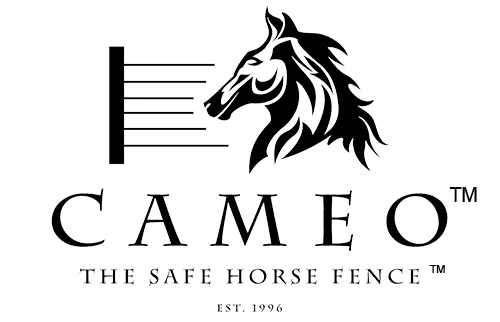What Is the Best Horse Fence for Your Property?
Choosing the best horse fence is one of the most important decisions property owners and barn managers will make. The right fence keeps horses safe, protects your investment, adds curb appeal to your property, and reduces future maintenance costs. With so many horse fencing options—ranging from wood to wire to monofilament—it can be overwhelming to make the right choice.
In this comprehensive guide, we’ll help you compare the most common materials used in equine fencing, evaluate cost and longevity, and understand how different fence types affect aesthetics, safety, and resale value. We’ll also explain why the Cameo Horse Fence System is one of the most flexible and reliable options on the market—especially for modern equestrian properties.
Whether you're building a new paddock or upgrading an aging system, this article will help you make a confident and informed decision about the best horse fence for your unique needs.
How Do Common Horse Fencing Materials Compare?
When evaluating horse fencing options, it’s critical to compare materials based on safety, visibility, cost, maintenance needs, and appearance. The best horse fence isn't always the most expensive—it’s the one that meets your horses' needs while aligning with your property goals and budget.
The most commonly used horse fencing materials include wood, vinyl, wire mesh, electric wire, pipe, and monofilament. Each has strengths and limitations depending on your climate, type of horses, terrain, and long-term maintenance capacity. For example, wood offers a traditional look but may splinter or rot over time, while wire is cost-effective but presents safety risks if not properly installed.
The Cameo Horse Fence System uses a high-visibility, tensioned monofilament line designed to stretch upon impact, greatly reducing the risk of injury. It combines low-maintenance materials with a clean, professional appearance—making it a top contender for horse owners seeking a modern fencing solution.
Pros and Cons of Horse Fencing Options
Below is a side-by-side comparison of popular horse fencing materials:
Wood Board
Pros: Traditional look, strong physical barrier
Cons: High maintenance, prone to rot or warping
Vinyl Rail
Pros: Low maintenance, attractive appearance
Cons: Brittle in cold climates, expensive to repair
Woven Wire
Pros: Good containment, affordable
Cons: Horses may get hooves caught in large gaps
Electric Wire
Pros: Effective deterrent, economical
Cons: Can be hard to see, risk of entanglement
Pipe Fencing
Pros: Strong, durable, minimal upkeep
Cons: High cost, can cause injury if horse hits it
Monofilament (Cameo)
Pros: Flexible, visible, low injury risk
Cons: Requires proper tensioning for best performance
How Much Does Horse Fencing Cost?
Budget is one of the biggest factors in choosing the best horse fence. Installation costs vary widely depending on materials, terrain, labor, and the size of the enclosure. Traditional wood fencing may run $7–$12 per linear foot, while vinyl and pipe fencing can climb to $15–$30 per foot. Wire and electric systems are cheaper to install but may pose higher long-term safety or maintenance costs.
The Cameo Horse Fence System offers an attractive balance between affordability and performance. On average, it costs significantly less than wood or pipe while offering enhanced visibility and safety features. Installation is straightforward, and ongoing maintenance is minimal, providing long-term value without compromising security.
When budgeting, always factor in: fencing material, gates, posts, brackets, installation labor (if applicable), and tools. A small difference in upfront cost can pay major dividends in lower repairs and peace of mind.
Which Horse Fence Offers the Best Durability and Maintenance?
Durability plays a key role in the long-term success of a fencing system. Aesthetic concerns aside, you want a fence that withstands weather, horse behavior, and time. Wood fences may need to be painted or repaired annually. Wire fences can rust or sag if not tensioned correctly. Pipe fencing is strong but expensive to fix if damaged.
Cameo fencing, on the other hand, is designed to resist UV degradation, weather-related fatigue, and high-impact force. The polymer monofilament line stretches rather than breaks, minimizing injury and preserving the structure. Universal brackets simplify repairs, and tensioning tools make it easy to maintain optimal performance year-round.
In terms of maintenance, the best horse fence is one that minimizes your hands-on time. Fewer repairs mean lower costs, better safety, and a more consistent look across your property.
How Does Fencing Choice Impact Property Value and Appearance?
Your fence is one of the first things visitors notice. A clean, well-maintained fence not only signals a professional equestrian operation but also adds curb appeal and resale value to your property.
When selecting a fencing system, consider how it complements:
-
Barn and outbuilding aesthetics
-
Landscape and natural terrain
-
Property lines and neighboring visuals
-
Future resale expectations
Cameo fencing delivers a polished, high-end appearance while blending seamlessly with rustic or modern barn styles. Its low-profile look is elegant yet secure, and the white monofilament lines stand out clearly in open pastures or wooded areas alike.
Why More Horse Owners Are Choosing Cameo
Here’s why the Cameo Horse Fence System stands out as one of the best horse fencing options on the market:
-
High-visibility white monofilament minimizes accidents
-
Flexible design stretches on impact, reducing injury risk
-
UV-stabilized polymer holds up against harsh sun and weather
-
Low-maintenance brackets, tensioning tools, and hardware
-
Adaptable to wood, vinyl, or metal posts
-
Cost-effective alternative to wood, vinyl, and pipe fencing
Whether you’re fencing a large pasture, a riding arena, or a private paddock, Cameo provides the security and ease of use that horse owners demand—without the hassle or hazards of traditional materials.
Resources
Internal link: Visit CameoFencing.com to explore fencing kits and accessories.
External link: Read Equus Magazine’s guide on horse fencing options for additional insights.

